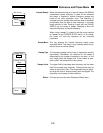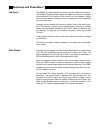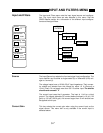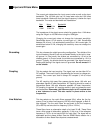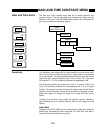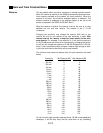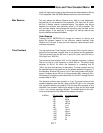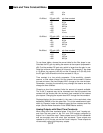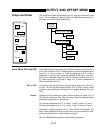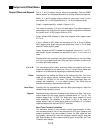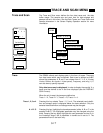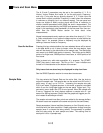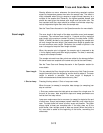
5-13
Gain and Time Constant Menu
Filter dB/oct This key selects the low pass filter slope (number of poles). Each pole
contributes 6 dB/oct of roll off. Using a higher slope can decrease the
required time constant and make a measurement faster. The filter slope
affects the minimum time constant (see above). Changing the slope may
change the time constant if the present time constant is shorter than the
minimum time constant at the new filter slope.
Synchronous Pressing this key selects no synchronous filtering (Off) or synchronous
filtering on below 200 Hz (<200 Hz). In the second case, the synchro-
nous filter is switched on when the detection frequency decreases below
199.21 Hz and switched off when the detection frequency increases
above 203.12 Hz. The detection frequency is the reference frequency
times the harmonic detect number. The Syncro indicator in the Settings
monitor (at the top of the screen) is turned on whenever synchronous fil-
tering is on.
When the synchronous filter is on, the phase sensitive detectors (PSD's)
are followed by 2 poles of low pass filtering, the synchronous filter, then 2
more poles of low pass filtering. The low pass filters are set by the time
constant and filter slope. If the filter slope requires less then 4 poles
(<24 dB/oct), then the unused poles are set to a minimum time constant.
The poles which are set by the time constant are the ones closest to the
PSD's. For example, if the time constant is 100 ms with 12 dB/oct slope
and synchronous filtering is on, then the PSD's are followed by two poles
of low pass filtering with 100 ms time constant, the synchronous filter,
then two poles of minimum time constant.
Synchronous filtering removes outputs at harmonics of the reference fre-
quency, most commonly 2xf. This is very effective at low reference fre-
quencies since 2xf outputs would require very long time constants to
remove. The synchronous filter does NOT attenuate broadband noise
(except at the harmonic frequencies). The low pass filters remove out-
puts due to noise and interfering signals. See the SR850 Basics section
for a discussion of time constants and filtering.
Note:
The synchronous filter averages the outputs over a complete period.
Each period is divided into 128 equal time slots. At each slot, the aver-
age over the previous 128 slots is computed and output. This results in
an output rate of 128xf. This output is then smoothed by the two poles of
filtering which follow the synchronous filter.
The settling time of the synchronous filter is one period of the detection
frequency. If the amplitude, frequency, phase, time constant or slope is
changed, then the outputs will settle for one period. These transients are
because the synchronous filter provides a steady output only if the input
is repetitive from period to period. The transient response also depends
upon the time constants of the regular filters. Very short time constants
(<<period) have little effect on the transient response. Longer time con-
stants (<period) can magnify the amplitude of a transient. Much longer
time constants (≥ period) will increase the settling time far beyond a
period.



